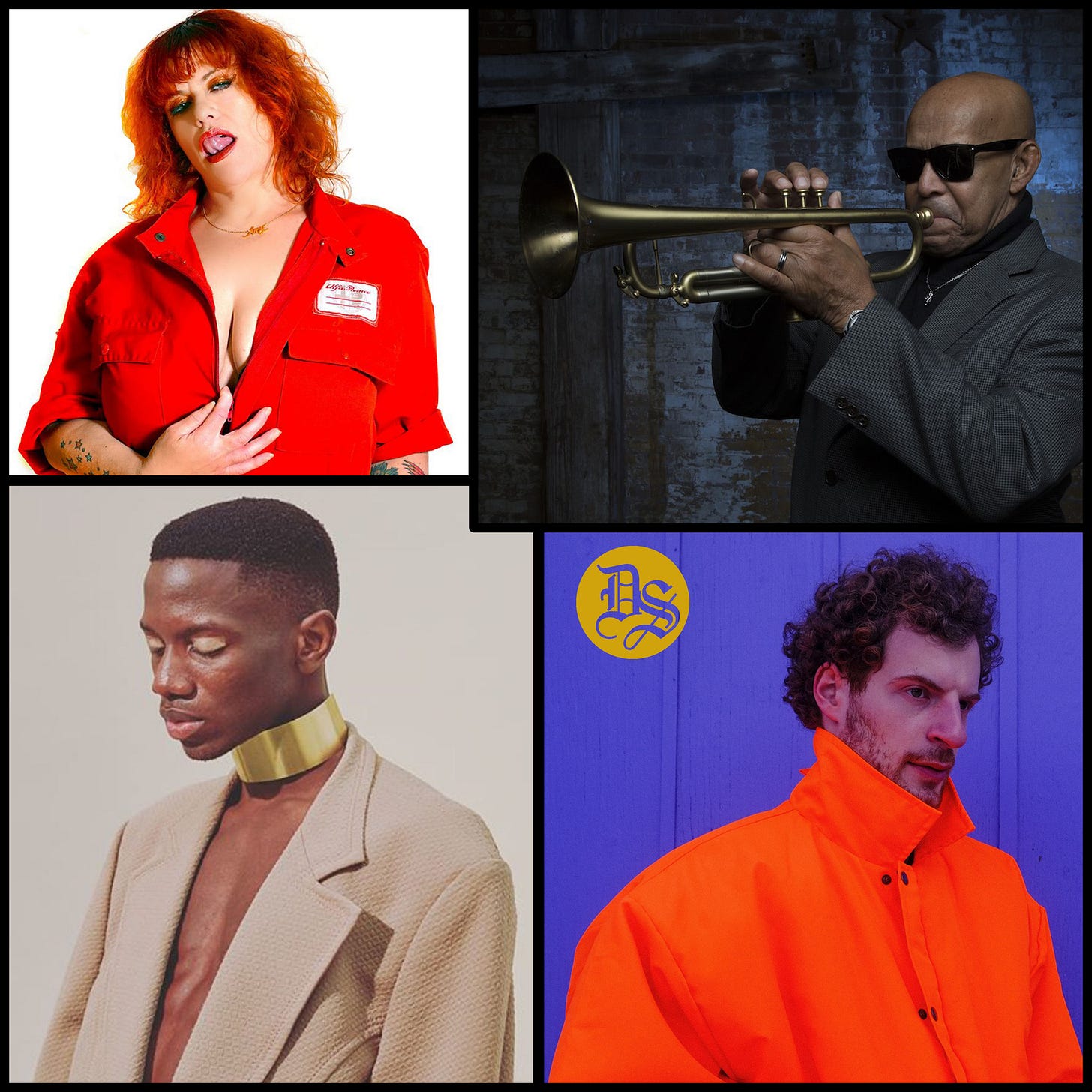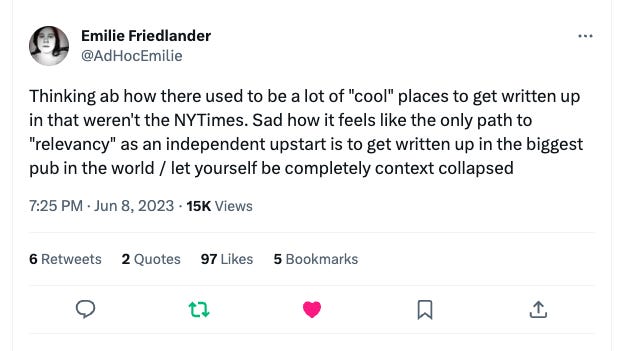Bklyn Sounds 6/20/2023 - 6/26/2023 + The Value(s) of Local Musicking
How watching people celebrate 79.5 is the opposite of "collapsing context" + Shows: Amy Douglas & "A Joyful Noise" / Eddie Henderson / Present Sounds x Photay / Authentically Plastic / and more.
On some level, the scene at the record release show for 79.5’s excellent self-titled sophomore album, at Brooklyn Made a couple of weeks ago, was no different than any other gig that celebrates a local band’s long-awaited new music. Oodles of frienergy and community support, opening acts/DJs ready with the testimonials, plus a comfortable looseness that signaled the evening as a party among people who were well-acquainted. There was also purposeful commerce and negotiation afoot, not least because of a prevailing belief that 79.5’s career arc retains a bright impactful future. And the evening’s evidence — t-shirt and vinyl sales going well, a cadre of local music-biz folks bound in conversation at the bar, young fans screaming lyrics along with the new tunes (admission: me too) — did nothing to disprove this notion.
Which is as it should be. Led by the harmony vocals of Kate Mattison and (now) Lola Adanna, 79.5 is molded as a classic New York disco band, mixing in soul and boogie, rock and old-school rap vibes. Their entrance onto a broader musical radar came courtesy of L. Michaels’ 2016 disco dub of the single “Terrorize My Heart,” a staple in DJ sets by the likes of Questlove, Giles Petersen and other discerning groove-minded selectors ever since. Yet 79.5 has been entrenched in the city’s live-disco circuit for going-on a decade, with Mattison’s songwriting (less big-band fantasias than soul-rock heart-scrapers) and arrangement approach of centering multiple female voices, standing the group apart. Women have been fronting bands throughout the city’s 21st Century disco revivals, but Mattison was among the crest of the wave — see also: Adeline Michelle (once of Escort), Underground System’s Domenica Fossati, Amy Douglas and Mattison’s former singing partners, Niya Parker Brown and Piya Malik now in Say She She — whose writing gives actual weight to the production. These are songs as much as dance grooves, carrying on the city’s Adams-Burgess/Rodgers-Edwards lineage.
On stage at Brooklyn Made, Adanna and Mattison, also playing keys, fronted the trio of bassist/producer Andrew Raposo, saxophonist Izaak Mills and drummer Caito Sanchez. It was a good-time show — Mills doing a duck walk on the stage-rim and blowing his sax through the crowd; Mattison, Adanna and Roposo practicing arena-rock choreography — more so than an intense performance. Drinks were consumed and spilled, and everybody approached the occasion with laughter, grace and abundance of positive energy. That was especially apparent of the family relations and friends who came to support the Brooklyn-born and -raised Adanna. It wasn’t just a couple people, it was a posse, and the joy they exhibited at her every onstage move — in a black latex bodysuit, no less — and every vocal turn, raised the air of camaraderie. Lola beamed something deeper than an artist’s usual sense of pride and relief at the acceptance of new work by a knowing and attentive community, and more universal than acknowledgement of emotional, lived-in support that family brings. It was the best possible mix of those energies — Adanna was having two homecomings at once, a rarity for a city where so much of the community is transplants, a reminder that it isn’t all of us. That New Yorkers making New York music about New York for other New Yorkers simply hits differently. The comfort of destroying a “need” for authentic context because one was naturally present.
As one of those New Yorkers, this was so immensely heartening to witness, and not only because so much of what passes for that authenticity context nowadays is a masquerade of signifying — the appearance of cultural knowledge represented by fluency of a few scattered memes about style and/or sound and/or history. Of course, none of this is new for this city. As a magnet for creative types, NYC has always attracted artists who arrive thinking themselves all-knowing, and striking that pose. Only to hit the realization that, in fact, there’s still plenty to learn, and maybe even that this education will result in an even more interesting creative voice. That education - at gigs, sessions, recordings, communities, searches, rip-offs and successes - *is* the authenticity context. And documentation of that artistic process is, in many ways, what local arts journalism is about. Watching the overlap of 79.5’s moment with Lola Adanna and her family’s, was a physical reflection on New York as a real space for people and generations, not an imagined one or a metaphor.
About a week after that gig I saw a Tweet about the sinking music-writing corner of the sinking mainstream media business, from Emilie Friedlander, who I know a bit from her time at The Fader. Friedlander has a podcast and Substack called The Culture Journalist, which is billed as a “cathartic conversation about culture in the age of platforms” that I tune into only occasionally — not because it doesn’t interest me, or I do not generally agree with the terms of the engagement, but because the ivory tower decay Friedlander details is a manifestation of globalist culture thinking I’m avoiding in favor of helping shape whatever might be next. (Rhythm Improvisation Community - all things the ivories aren't very good at.) And yet, this tweet about the loss of different ways to tell artist stories, was brilliant in its short-hand reinforcement about the importance of witnessing, capturing and broadcasting moments like the one I saw with 79.5 and Lola Adanna’s people at Brooklyn Made.
That end-note about “let[ting] yourself be completely context collapsed” by “the biggest pub in the world” felt especially poignant, and New York-specific. Maybe it applies less to a decade-long artist like Mattison and 79.5, but this is the schizophrenic pond in which 99% of the city’s musical artists reside. It’s either an ocean of global media conglomerates operating by their own rules, leaving the context of the artistic work “collapsed” in the broadest way possible; or the algorithmically limited creek of social-media feeds and Bandcamp pages, in which the work suffocates in a too-small feedback loop, a natural limit of that educational “authenticity context.”
The scene at Brooklyn Made, bearing witness to it, was documenting evidence of a middle-ground between such extremes. Proof of the importance of stories that might not be quite ready for “the biggest pub in the world” but have most definitely long outgrown the social media circle. Stories of cultural multitudes percolating and making a not-necessarily-radical ruckus on the street level below the ivory towers. Stories that present an inkling of devotion to inter-generational middle-class values, without being reactionary, or projecting some extractive aspect onto them.
This Week’s Shows:
Keep reading with a 7-day free trial
Subscribe to Dada Strain to keep reading this post and get 7 days of free access to the full post archives.




